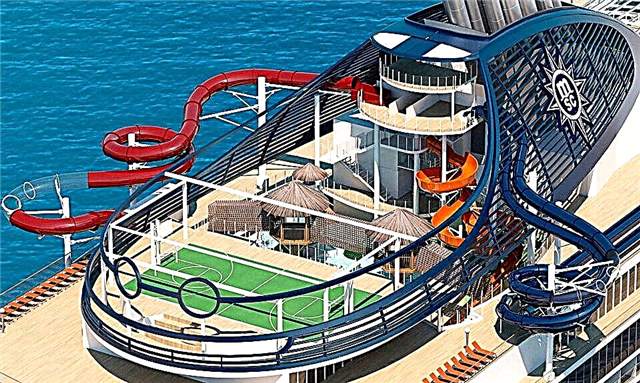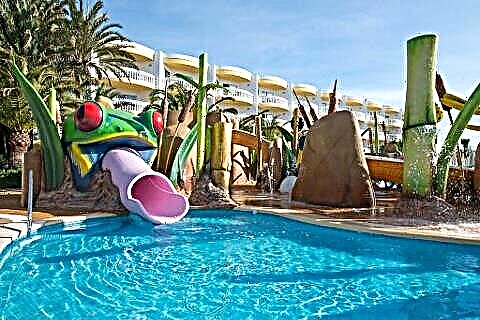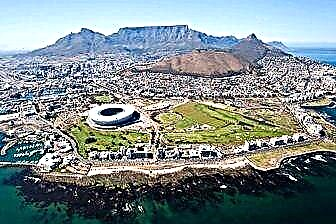Address: Russia Moscow
Foundation date: 1584 year
Main attractions: Church of the Descent of the Holy Spirit, Cathedral of the Nativity of the Blessed Virgin
Coordinates: 55 ° 44'23.0 "N 37 ° 35'58.1" E
Content:
The ancient Conception monastery was founded in the 60s of the XIV century. Like many monasteries in Moscow, it experienced periods of prosperity and decline. Throughout its centuries-old history, fires, wars and persecutions of the church destroyed the monastery more than once, but it was still reborn from the ashes. Today it is one of the most beautiful monasteries in the city, and its doors are open every day for pilgrims and tourists.

The Conception Monastery from a bird's eye view
The history of the monastery in the XIV-XVII centuries
Metropolitan Alexy is considered the founder of the monastery. He erected a small church dedicated to the Conception of Righteous Anna, and nuns began to live with her. The sisters of the church hierarch, nuns Juliana and Eupraxia, were the first to settle here. They headed the first monastery in the Moscow principality, created exclusively for women.
The nunnery had a strict charter and was highly respected by Muscovites. He set an example for new women's convents, which one by one began to appear on Moscow land.
Over time, the monastery became known as a place that helped childless couples. The spouses, who had no children, made a pilgrimage to the monastery and prayed fervently in its temples. The most famous visitors here were the Russian Tsar Fyodor Ioannovich and his wife. Soon after visiting the monastery, Queen Irina became pregnant, and the royal family had a daughter, Anna. Wishing to immortalize the joyous event, the tsar built a stone church of St. Anna, and her chapels were dedicated to the heavenly patrons of the royal couple - Fedor Stratilat and St. Irene.

View of the monastery from the 2nd Zachatievsky lane
Most of the monastery buildings were made of wood, and therefore often burned in fires. In the middle of the 16th century, Muscovites experienced one of the most severe fires that devastated the central part of the city. From the raging flames, the monastery burned out to the ground. However, time passed, and thanks to the efforts of the nuns and donations from the townspeople, the monastery was rebuilt.
Another misfortune came in the Time of Troubles. The Polish-Lithuanian troops ravaged the monastery so that for almost a hundred years the monastery stood in a dilapidated state, and it was only possible to restore it under Peter I. Once again, the monastery suffered during the war with Napoleon. Monastic buildings and temples were burnt, but then they were rebuilt with money collected by the laity.
In the 19th and early 20th centuries, several beautiful stone churches, fraternal buildings and outbuildings appeared in the Conception Monastery. Here women from the most eminent families of Russia took monastic vows. At the same time, there was an almshouse in the monastery for the poor and sick old women, as well as an orphanage where orphans were kept.

Monument to St. Alexis, Metropolitan of Moscow against the background of the Conception Monastery
The monastery was closed in 1927. Several years later, in the midst of an active anti-religious campaign, the cathedral church and the bell tower were blown up. Only by a miracle did the believers manage to save several ancient icons, and they were kept for a long time in the nearby church of Elijah the Prophet.
In 1934, a typical Soviet school grew up on the territory of the monastery, the Church of the Descent of the Holy Spirit was deprived of its head and converted into an ordinary building, and the monastery fence was demolished. For several decades, in this corner of Moscow, nothing reminded of the ancient women's monastery that had stood for several centuries.
In the late 1990s, the buildings and land were transferred to the church, and work began to restore the monastery. The first church services were held here in 1993, and two years later the small community received the status of a women's Orthodox monastery.

Northern Monastery Gate under the Temple of the Image of the Savior Not Made by Hands
In the early 2000s, by order of the Moscow mayor's office, large-scale archaeological excavations were carried out on the monastery territory. Experts have discovered the foundations of ancient temples, more than a thousand medieval graves, parts of a 16th century stone refectory and several cellars of wooden cells. Ancient Arab coins, fragments of one-color porcelain from China and a ceramic washstand, which is more than 500 years old, are valuable finds.
Cathedral temple
The monastery cathedral is dedicated to the Nativity of the Most Holy Theotokos and occupies a central place on the territory of the monastery. It was rebuilt and consecrated in 2010. The majestic temple impresses with its harmonious proportions, impressive dimensions and beautiful interior decoration. It rises to a height of 48 m and has an interior area of 3800 sq. m. The entrance to the church is made in the form of a "red porch" and is decorated with intricate stone carvings.
The large five-domed cathedral has cross-domed vaults. It consists of several temples on the ground floor and a large underground part. In total, 10 thrones have been consecrated in the cathedral. The central iconostasis is five-tiered, and the iconostases in the side-altars have three tiers. The craftsmen of the Holy Trinity Brotherhood, located in the small Russian town of Shchigry, participated in their manufacture.

Gate Church of the Savior Not Made by Hands
The founders of the monastery, nuns Juliana and Eupraxia, were buried under the cover of the Kazan side-chapel of the cathedral. Every year on May 16, the monastery celebrates the day of remembrance of these revered saints. Believers come to pray to the ancient tomb and ancient icons of Our Lady "the Merciful".
In the underground part of the cathedral, you can see fragments of four temples that preceded it and about 150 stone tombstones, under which the Bolotnikovs, Vorontsovs, Usoltsevs, Koscheevs, Golovkins and other representatives of eminent Moscow families rest. In addition, there are two small underground churches. Pilgrims and tourists in the underground are greeted by a monastery ossuary and a skull with the inscription: "We were like you, and you will be like us."
The architectural ensemble of the monastery
In addition to the restored cathedral church, in the monastery you can see the temple of the Descent of the Holy Spirit and the gateway church. In the refectory is the Church of the Conception, and under the gate church is the chapel of Metropolitan Alexy. In the northern part of the monastery there are old stone buildings - the refectory and abbot buildings.

Cathedral of the Nativity of the Blessed Virgin
The one-domed gate church of the Savior Image Not Made by Hands appeared at the end of the 17th century. It is a sample of the "Naryshkin" Baroque, painted in dark red and decorated with snow-white platbands, columns and cornices. The temple was built thanks to the royal steward L. A. Rimsky-Korsakov, and for a long time played the role of a house church for this noble family. From the moment of its construction until its closure in 1924, it was listed not as a monastery, but as a parish.
The Church of the Savior of the Image Not Made by Hands managed to survive the destruction of the Soviet period. Other monastery buildings were destroyed or overhauled and had to be rebuilt. It is noteworthy that the ancestral tomb of the Rimsky-Korsakov family has been preserved in the basement of this temple.

In the foreground is the Church of the Descent of the Holy Spirit
The monastery today
The Conception Monastery is active, and 24 nuns and their abbess constantly live in it. Repair and restoration work continues here, but despite this, the doors of the monastery are open to pilgrims and tourists any day from morning to evening. Church services in the monastery churches are held daily: on weekdays at 7.00 and 17.00, and on Saturdays and Sundays - at 8.30 and 16.00.
Nuns and novices are engaged in the restoration of temples and buildings. They work in a bakery, sewing workshop and prosphora.Several sisters constantly serve a courtyard in the Moscow region of Barvikha, where there is an Orthodox church, a Sunday school for children of believers and a small subsidiary farm.
The monastery has its own publishing house, so those who come here have the opportunity to buy Orthodox literature. As in the old days, an almshouse is opened in the monastery, in which sick and elderly nuns and lay women live today.

Abbess Corps
How to get to the monastery
The monastery territory is located 1.5 km south-west of the Moscow Kremlin, in the 2nd Zachatyevsky lane, 2. The monastery is located in the Khamovniki district. It is not difficult to walk to it in 10 minutes from the metro stations "Kropotkinskaya" or "Park Kultury". Nearby, on Ostozhenka Street, bus A makes a stop.











